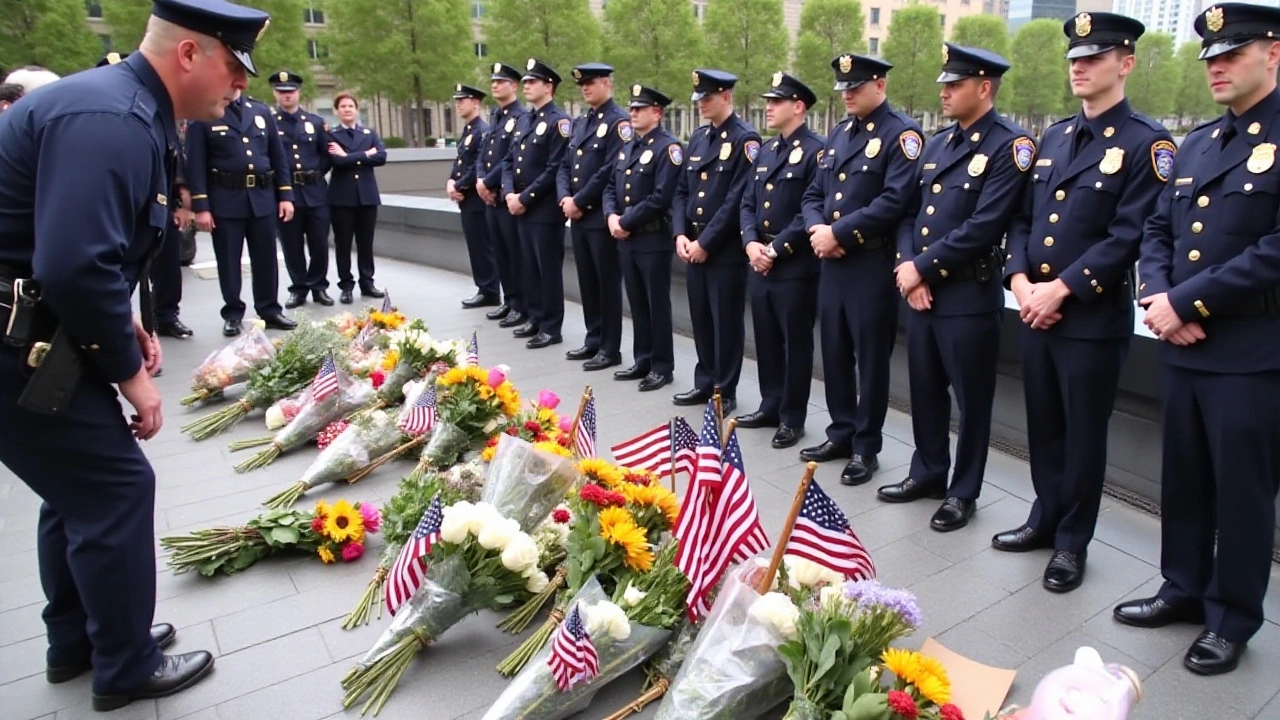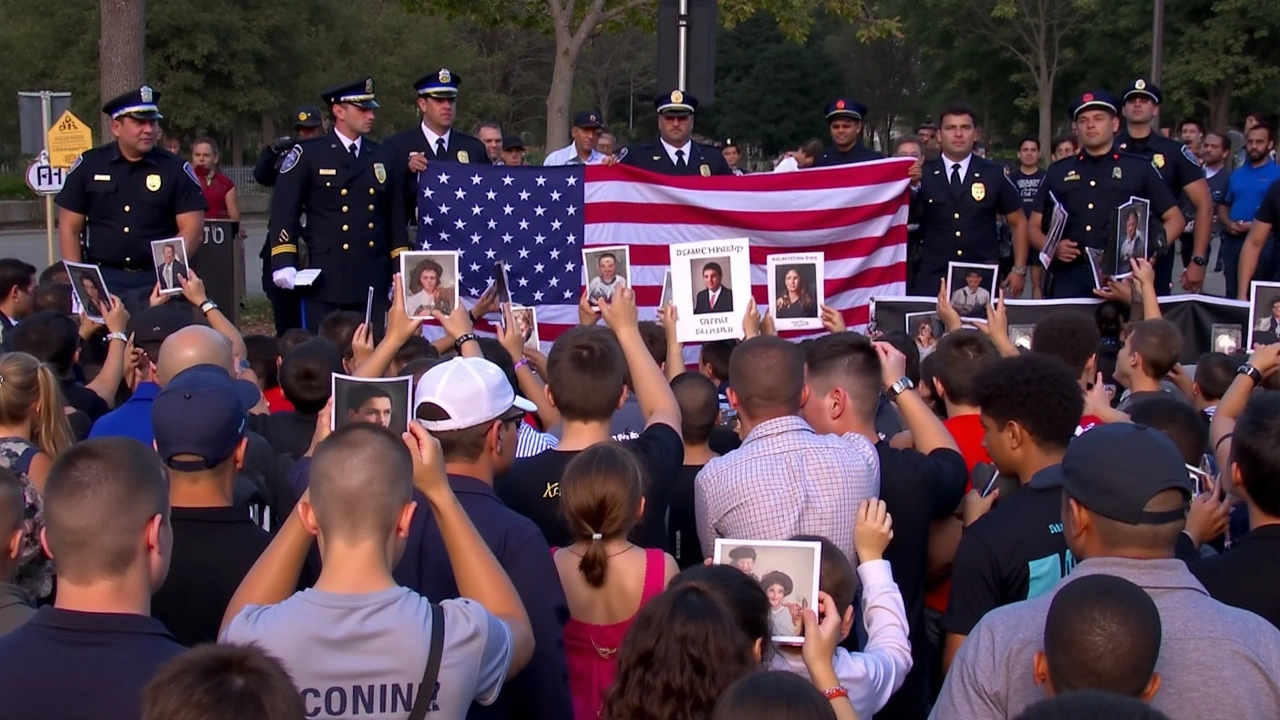9/11 Anniversary Tribute: A Reflection of Generational Change at Ground Zero
At the heart of Manhattan, amid the bronze panels of the 9/11 Memorial inscribed with the names of the fallen, a new mosaic of voices will resonate through Ground Zero this year. Each year, the annual tribute honoring the nearly 3,000 lives lost in the 2001 terrorist attacks becomes a deeply personal event. This year marks a significant shift as younger generations, including those born after the tragedy, are taking a more active role in reading the victims' names.
Children and young adults, guided by their familial connections and the need to preserve the memories of their loved ones, stand in for their elders to read the names aloud. Among these new voices is 13-year-old Allan Aldycki. For the past two years, he has been an integral part of this annual remembrance, reading names and preserving the legacy of those who were lost. His participation is deeply rooted in personal history; his grandfather, Allan Tarasiewicz, was a firefighter who perished during the attacks.
Allan Aldycki’s sense of duty and honor towards his late grandfather extends beyond the ceremony. He views this act not just as a tribute but as an educational platform. Through his involvement, Allan educates his friends and peers about the significance of 9/11, so they can understand why this day is remembered so solemnly. For him, and many others, passing on these stories is crucial to ensuring the enormity of the event is not forgotten by the younger generations.
A Broader Tradition of Remembrance
This tradition of reading victims’ names is not exclusive to the 9/11 memorials. It is a poignant and powerful way of remembrance that has been adopted in memorials for various tragedies throughout history. Similar practices are observed at other significant memorials such as the Oklahoma City bombing and the Holocaust memorials, where the recitation of names serves to bring individual identities back to the forefront from the overwhelming numbers.
In line with this tradition, the observances at the Pentagon and the Flight 93 National Memorial in Shanksville, Pennsylvania, include similar ceremonies. At each site, names of those who perished are read aloud, ensuring that their stories and sacrifices are remembered. This year, the 9/11 Memorial ceremony in New York will be broadcasted live by NBC 4 New York from 8:30 a.m. to 12:30 p.m. ET, bringing this event into homes and communities across the nation.

Passing the Torch
The involvement of younger generations in these ceremonies brings to light a broader theme of passing on the torch of memory and legacy. As time progresses, those who experienced or directly remember the events of 9/11 grow older, and it falls upon the younger generations to continue this poignant tradition. The participation of young relatives like Allan Aldycki ensures that the grief and resilience associated with 9/11 are not just historical footnotes, but living memories carried forward with sincerity and respect.
Each year’s ceremony at Ground Zero includes the reading of the names of the 2,977 victims from the three attack sites, as well as the six individuals who lost their lives in the 1993 World Trade Center bombing. The act of reading these names is more than a ceremony; it’s a collective vow to always remember and honor the lives taken on that fateful day.
As young voices join the chorus of remembrance, the 9/11 anniversary tribute becomes a bridge between the past and the future. It underscores the human aspect of this history, reminding everyone that behind each name is a life lived and a story worth telling. By integrating young generations into this sacred ritual, the tradition of remembrance evolves, ensuring that the legacy of the victims endures indefinitely.
Through the voices of children and young adults, the significance of 9/11 continues to resonate, weaving into the fabric of their shared heritage. These young relatives, standing tall where their elders once did, bring a renewed sense of hope and continuity. Their participation signifies the unwavering promise to never let the memory of that day fade, creating an unbroken chain of remembrance that binds the past with the present and the future.


John Crulz
Seeing kids step up at Ground Zero really hits home. It’s amazing how a 13‑year‑old can carry that weight with grace. The younger generation keeps the memory alive in a way that feels fresh. It also shows that history isn’t just for the older folks to talk about. I think we all benefit when kids share these stories with their peers.
Anita Drake
Including relatives in the reading ceremony bridges the gap between past and present. It transforms a solemn event into a living lesson for schools and families. When a child like Allan speaks, the names become more than a list – they become personal connections. This practice also teaches respect and empathy early on.
Eduardo Lopez
The sight of a teen standing before the bronze names is nothing short of moving, a tableau of innocence meeting tragedy. Allan’s voice cuts through the morning hush, echoing across the plaza like a pledge that we will not forget. Each syllable he utters carries the weight of his grandfather’s badge, the smell of smoke, and the roar of sirens. He is not merely reciting; he is performing a ritual that binds generations together. The ceremony, once a solemn duty of survivors, has evolved into a living classroom where youth become the custodians of memory. This shift signals a cultural rebirth, turning static remembrance into dynamic dialogue. As he reads each name, listeners sense the individual stories behind the statistics, a reminder that every number once had a heartbeat. His classmates watch, learning that sacrifice is not an abstract concept but a personal one. The media coverage amplifies this moment, broadcasting a narrative where the future takes an active role in honoring the past. It also challenges other memorials to consider similar intergenerational involvement. The psychological impact on young participants is profound; studies show that direct engagement with history fosters empathy and civic responsibility. Moreover, families find solace in seeing their children carry the torch, a symbolic continuation of loved ones’ legacies. The ceremony’s expansion to include schools and community groups further democratizes remembrance. In the quiet after the names are spoken, a palpable sense of continuity settles over the crowd. Ultimately, Allan and his peers prove that memory is not a museum piece, but a living, breathing thread that weaves through each new generation, ensuring that the tragedy’s lessons endure.
Nancy Perez de Lezama
In addition to the educational value, involving relatives also provides a therapeutic outlet for families, allowing them to honor their loved ones in a personal manner.
Matt Heitz
The paradigm shift you described aligns with the sociocultural transmission theory, wherein intergenerational narrative functions as a mnemonic scaffold. By operationalizing remembrance through performative praxis, we mitigate collective amnesia. Moreover, the integration of youth into ritualistic commemoration leverages affective learning pathways, enhancing epistemic retention. This stratagem embodies both symbolic interactionism and resilience engineering within memorial discourse.
Susan Mark
For anyone curious about how to get involved, local schools often coordinate volunteer slots with the memorial foundation. They’ll provide training on name pronunciation and the ceremony protocol. It’s a great way to give back and learn more about the history.
Jason Jennings
Honestly, the whole thing sounds noble but it’s just another way for the media to push their agenda. We should focus on protecting our country instead of playing sentimental games.
Diego Vargas
i think its cool how the kids get to read the names. it makes the memorial feel more real for the younger genrations. plus its a good reminder that we cant forget.
Alex Lee
this is just a staged emotional stunt. it doesn't change anything.
Vida Yamini
I have to say that the inclusion of younger voices at such a solemn event is a profoundly important development it signals that we are not simply locking history away in stone it brings a sense of continuity that is vital for any society to thrive we need living connections to our past so that the lessons learned are not abstract concepts that fade with time this practice also encourages schools to incorporate real‑world history into curricula allowing students to engage with the material on a personal level it fosters empathy and a deeper understanding of what these families endured it also creates a communal space where grief can be shared across ages bridging the gap between those who lived through the tragedy and those who only know it through textbooks the emotional resonance of hearing a child's voice recite each name cannot be overstated it reminds us that behind every statistic is a human story it also serves as a call to action for future generations to uphold the values of resilience and unity that emerged from that dark day in our nation's history
James Lawyer
The observations you raise merit further scholarly examination, particularly regarding the pedagogical impact of intergenerational participation in public remembrance ceremonies.
Abby Culbertson
It’s heartbreaking but hopeful.
Awolumate Muhammed Abayomi
Yea man its like we feel the pain and also see da future hope shining through yo
Josh Tate
Seeing these young people stand up makes the memorial feel like a living conversation rather than a static monument. It reminds us that the act of remembrance is ongoing, not just a yearly checkbox. When they speak, you can sense the weight of history meeting the optimism of youth.
John Smith
Statistically speaking, early exposure to commemorative practices correlates with higher civic engagement later in life; it's a well‑documented phenomenon in social science literature.
Alex Soete
Exactly! Let’s keep pushing this forward-more schools, more youth, more voices. Together we’ll make sure the memory stays vibrant and powerful for generations to come.